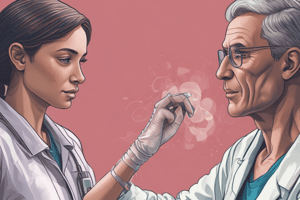Podcast
Questions and Answers
What is the primary pathogenic organism responsible for tuberculosis?
What is the primary pathogenic organism responsible for tuberculosis?
- Mycobacterium leprae
- Streptococcus pneumoniae
- Mycobacterium tuberculosis (correct)
- Escherichia coli
What is the expected volume of blood in massive hemoptysis in a 24-hour period?
What is the expected volume of blood in massive hemoptysis in a 24-hour period?
- 100-200 ml
- Above 800 ml
- 600-800 ml
- 200-600 ml (correct)
Which of the following describes Mycobacterium tuberculosis?
Which of the following describes Mycobacterium tuberculosis?
- Gram-negative and sporing
- Strongly gram-positive and encapsulated
- Weakly acid-fast and aerobic (correct)
- Sporing and motile
What type of microscopy is crucial for the laboratory identification of TB?
What type of microscopy is crucial for the laboratory identification of TB?
What should be done if the second sputum specimen is not submitted within three days of the first specimen?
What should be done if the second sputum specimen is not submitted within three days of the first specimen?
Which of the following media is NOT commonly used for culturing Mycobacterium tuberculosis?
Which of the following media is NOT commonly used for culturing Mycobacterium tuberculosis?
What is the minimum volume required for a sputum sample to be valid for Xpert MTB/RIF testing?
What is the minimum volume required for a sputum sample to be valid for Xpert MTB/RIF testing?
What is the main characteristic of Mycobacterium that contributes to its acid-fastness?
What is the main characteristic of Mycobacterium that contributes to its acid-fastness?
Which tools are required for smear preparation?
Which tools are required for smear preparation?
In terms of TB epidemiology, what is considered the primary source of infection?
In terms of TB epidemiology, what is considered the primary source of infection?
Which test result is NOT typically associated with Mycobacterium tuberculosis?
Which test result is NOT typically associated with Mycobacterium tuberculosis?
Why is it important to avoid food particles or solid particulates before collecting a sputum specimen?
Why is it important to avoid food particles or solid particulates before collecting a sputum specimen?
Which of the following is NOT recommended prior to sputum collection?
Which of the following is NOT recommended prior to sputum collection?
What is the sequence of actions a patient should perform to collect a good quality sputum sample?
What is the sequence of actions a patient should perform to collect a good quality sputum sample?
What type of procedure does DSSM primarily involve?
What type of procedure does DSSM primarily involve?
What should the healthcare provider do before collecting a sputum sample?
What should the healthcare provider do before collecting a sputum sample?
What type of glass slides should be used for smear preparation?
What type of glass slides should be used for smear preparation?
Which of the following statements about the growth characteristics of Mycobacterium is accurate?
Which of the following statements about the growth characteristics of Mycobacterium is accurate?
What is the primary purpose of using the ZIEHL NEELSEN AFB stain?
What is the primary purpose of using the ZIEHL NEELSEN AFB stain?
When preparing a smear, what technique should be used to ensure sterilization during the process?
When preparing a smear, what technique should be used to ensure sterilization during the process?
What is the required size of the smear to be prepared on the slide?
What is the required size of the smear to be prepared on the slide?
What is the recommended action after interpreting results and documenting them on laboratory forms?
What is the recommended action after interpreting results and documenting them on laboratory forms?
What advantage does fluorescence microscopy using LEDs provide compared to traditional microscopy methods?
What advantage does fluorescence microscopy using LEDs provide compared to traditional microscopy methods?
What should be done with the concrete preparation while steaming with carbol fuchsin to avoid drying?
What should be done with the concrete preparation while steaming with carbol fuchsin to avoid drying?
What color do acid-fast bacilli appear after primary staining with carbol fuchsin?
What color do acid-fast bacilli appear after primary staining with carbol fuchsin?
Which of the following bacteria is NOT classified as acid-fast?
Which of the following bacteria is NOT classified as acid-fast?
What is the purpose of counterstaining with methylene blue in the AFB staining method?
What is the purpose of counterstaining with methylene blue in the AFB staining method?
During the heat-fixing process, what must be exercised due to safety concerns?
During the heat-fixing process, what must be exercised due to safety concerns?
What is the effect of insufficient heat during the heat-fixing step?
What is the effect of insufficient heat during the heat-fixing step?
What should be done with the sputum specimen before transferring it to the slide?
What should be done with the sputum specimen before transferring it to the slide?
Which of the following is a key feature of the RITM Proficiency Testing for AFB?
Which of the following is a key feature of the RITM Proficiency Testing for AFB?
What is the correct procedure right after washing off excess carbol fuchsin?
What is the correct procedure right after washing off excess carbol fuchsin?
What is a significant advantage of Auramine-O staining over traditional Ziehl-Neelsen staining?
What is a significant advantage of Auramine-O staining over traditional Ziehl-Neelsen staining?
How does LED fluorescence microscopy improve diagnostic processes for TB?
How does LED fluorescence microscopy improve diagnostic processes for TB?
What is a primary benefit of adopting digital microscopy systems in laboratories?
What is a primary benefit of adopting digital microscopy systems in laboratories?
How long should a smear be air dried before fixing it by heat?
How long should a smear be air dried before fixing it by heat?
Which benefit does digital microscopy provide that aids in enhancing quality control?
Which benefit does digital microscopy provide that aids in enhancing quality control?
What role does RITM serve in the context of tuberculosis diagnosis in the Philippines?
What role does RITM serve in the context of tuberculosis diagnosis in the Philippines?
What is one of the aims of improving accuracy in TB diagnosis?
What is one of the aims of improving accuracy in TB diagnosis?
What aspect of LED fluorescence microscopy contributes to its cost-effectiveness?
What aspect of LED fluorescence microscopy contributes to its cost-effectiveness?
Study Notes
Laboratory Identification of Tuberculosis
- Tuberculosis (TB) is a contagious bacterial infection, primarily affecting the lungs but can also involve other body parts.
- Early and correct diagnosis is essential for effective TB treatment and preventing transmission.
- Laboratory identification is crucial, utilizing techniques such as direct sputum smear microscopy (DSSM), culture-based methods, and molecular assays.
Mycobacterium Characteristics
- Mycobacteria are aerobic, non-motile, non-capsulated, and non-sporing bacteria.
- Mycobacterium tuberculosis (Mtb) is weakly gram-positive, strongly acid-fast, and known as acid-fast bacilli (AFB).
- Liquid media for culture include Dubos’, Middlebrook’s, Proskauer and Beck’s, Sula’s, Sauton’s, and L–J media.
Epidemiology and Infection
- TB is the 13th leading cause of death globally and is the second leading infectious killer after COVID-19.
- Infection sources are typically open cases of pulmonary TB; initial infections are termed primary infections.
- Severe hemoptysis is defined as the expectoration of large blood volumes (200-600 ml in 24 hours) from the respiratory tract.
Sputum Sample Collection
- Ideal sputum collection methods involve spot-spot, early morning-spot, and early morning-early morning specimens.
- Proper mouth cleaning and techniques for producing good-quality sputum are critical, including deep breaths and strong coughing.
- Sputum samples should be minimally 5-10 ml for DSSM and 1 ml for Xpert MTB/RIF testing.
Direct Sputum Smear Microscopy (DSSM) Procedure
- DSSM can be performed via conventional Ziehl-Neelsen microscopy or fluorescence microscopy (FM), with FM providing increased sensitivity.
- Key steps include recording patient information, preparing and staining the smear, decoding results, and timely communication of findings to the requesting unit.
AFB Staining Method
- Ziehl-Neelsen is a method used to stain acid-fast bacilli, which retain the primary stain (carbol fuchsin) and appear red post-staining.
- Non-acid-fast bacteria will take on counterstains and appear blue or green.
- Heat-fixing slides properly is crucial; overheating or insufficient fixation can damage bacteria or smears.
Recent Updates in TB Diagnosis
- Fluorochrome Staining (Auramine-O): Has shown greater sensitivity and faster reading times than traditional stains.
- LED Fluorescence Microscopy:
- More energy-efficient, improving accessibility in resource-limited environments.
- Studies indicate better TB detection rates in low-resource settings compared to conventional microscopy.
- Digital Microscopy:
- Offers automation, reducing errors and increasing throughput.
- Facilitates image archiving and remote diagnostics for quality control.
RITM Proficiency Testing for AFB
- The Research Institute for Tropical Medicine (RITM) implements proficiency testing as part of the National Tuberculosis Control Program (NTCP).
- Key features include:
- Evaluation of laboratory competency in AFB testing.
- Assurance of quality through extensive quality assurance processes.
- Accreditation and certification of laboratories for standardized diagnostic practices.
- External Quality Assessment (EQA) to maintain diagnostic accuracy.
- Enhancing overall TB control efforts through improved diagnostic reliability.
Studying That Suits You
Use AI to generate personalized quizzes and flashcards to suit your learning preferences.
Description
This quiz focuses on the laboratory identification methods for tuberculosis, particularly emphasizing updates on direct sputum smear microscopy. Understanding these diagnostic techniques is essential for effective treatment and prevention of TB transmission. Test your knowledge on the role of laboratory identification in managing this contagious disease.




